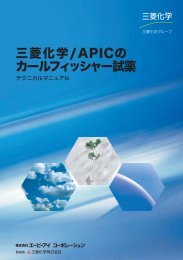Development of Karl Fischer Reagents
Development of Karl Fischer Reagents
Development of Karl Fischer Reagents
You also want an ePaper? Increase the reach of your titles
YUMPU automatically turns print PDFs into web optimized ePapers that Google loves.
Chapter I: Basic Knowledge<br />
(1) Upright solid sampling bottle<br />
An upright solid sampling bottle (Figure 11) is used for ordinary<br />
powdered, granular or lumpy samples. This type <strong>of</strong> sampling bottle is<br />
used frequently.<br />
(2) Angled solid sampling bottle<br />
A drawback with upright sampling bottles is that the sample must be<br />
shaken to some extent to make it drop to the bottom. The angled bottle<br />
solves this problem by means <strong>of</strong> a half-rotational bend that allows the<br />
sample to fall (Figures 12, 13). The angled-neck bottle is especially<br />
suitable for plastic pellets.<br />
(3) Trace solid sampling bottle<br />
This container (Figure 14) is used to obtain extremely small amounts <strong>of</strong><br />
samples with a high moisture content. It is suitable for powdered<br />
samples.<br />
(4) Syringe-type sampling bottle<br />
The syringe-type sampling bottle (Figure 15) is used for consolidated<br />
powders and viscous solids. The sample is drawn into the syringe by<br />
pulling out the plunger, and then expelled the contents into the system by<br />
pushing in the plunger.<br />
(5) Sampling bottle for semi-solids<br />
This container (Figure 16) is used for high-viscosity samples, such as<br />
greases. The sample is first taken onto the sampling spoon (A), which is<br />
then weighed together with the bottle (B). Next, the sample is inserted<br />
into the titration flask together with the sampling spoon. The spoon is<br />
stirred for a period to allow the sample to dissolve. On completion <strong>of</strong> the<br />
measurement the sampling spoon is returned to the sampling bottle,<br />
which is then weighed. The difference between the two weights is the<br />
weight <strong>of</strong> the sample.<br />
Figure 11:<br />
Upright Sampling Bottle<br />
Figure 12:<br />
Angled Sampling Bottle<br />
Figure 13:<br />
Angled-neck Sampling Bottle<br />
57




